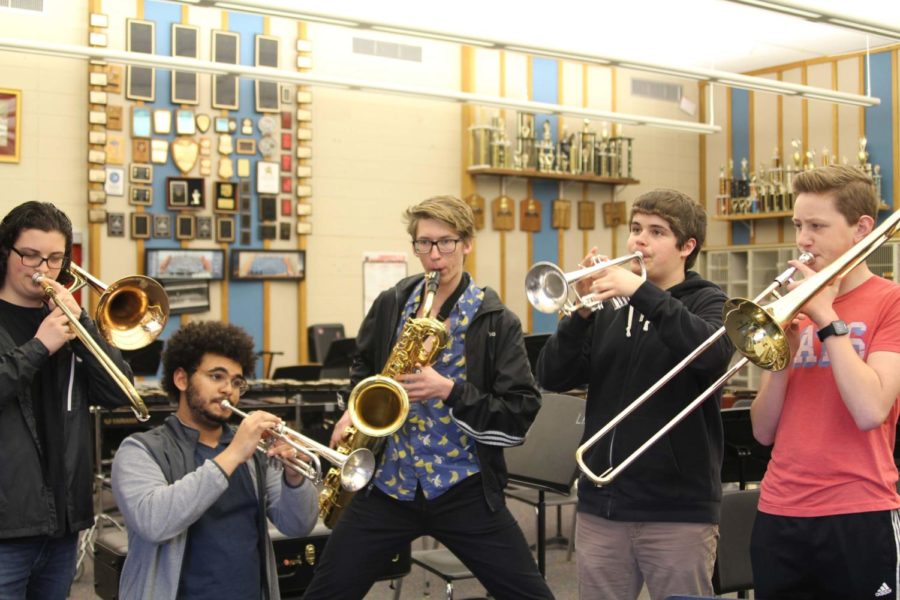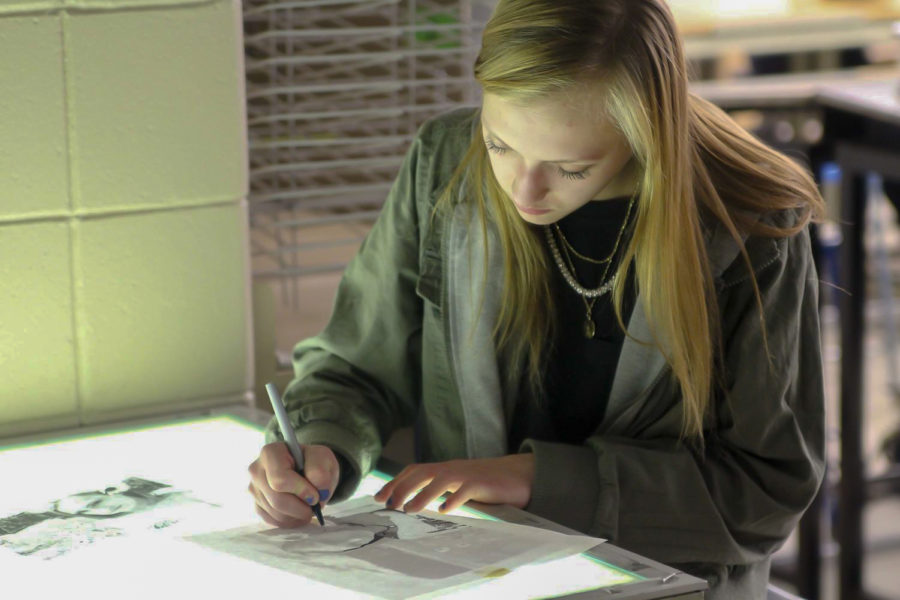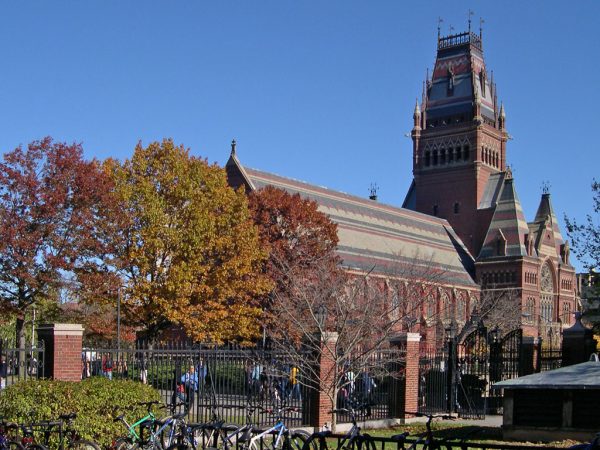Students, parents and faculty express concern over sample elementary schedule
A sample schedule containing changes to the elementary school schedule is sparking a community discussion on the importance of the arts in schools
Some fine arts teachers are concerned that limiting instruction time in elementary school would make students less likely to explore art electives like this drawing class when they get to high school.
The Sioux Falls School District (SFSD) is facing widespread community backlash over a sample elementary school schedule that would cut fine arts and P.E. instructional time by 25 percent.
The plan has caused considerable resistance among parents and students who see the fine arts as one of the most integral parts of a child’s education.
According to documents released by the Argus Leader, the suggested system would implement a 45-minute block of time each day for library, art, physical education and music. Each class would rotate a day every week, taking place on Monday one week, Tuesday the next, etc. Additionally, instead of being pulled out of class for band or orchestra, fifth-grade students would receive 45 minutes of instrumental instruction, but would consequently miss Library, Art, Music or P.E -whatever “special” is on the schedule for that particular day.
‘It isn’t about the budget’
In a statement sent to several people who voiced concerns over email, Superintendent Dr. Brian Maher stated that the changes were suggested because “…teachers told us they wanted/needed a less chaotic schedule.” The schedule has been going through the development process for three years.
The district emphasizes that this schedule is one of many sample schedules being considered. On Wednesday, Maher also clarified that the scheduling cuts are not related to the 2020 budget, which does include budget reductions for other areas.
“I’ll reiterate – this is not something that we’re looking at due to budget cuts. This is about putting together a schedule that makes sense for student outcomes…and our teachers,” said Maher.
‘I can’t imagine cutting that time’
Parents, students and fine art educators are concerned that this plan could hinder the ability of students to become proficient in all subject areas, and therefore impede upon their development in other areas.
A Facebook group created by Heather Dewit on Tuesday night named “It All Matters” had almost 2,000 members as of Friday night. An image created by the group quickly started circling around social media. LHS junior Adam Zimmel shared the image by posting it on his Instagram account.

“Test scores are better when children participate in [the arts],” said Zimmel. “It gives them a way to express themselves in a way that the core curriculum doesn’t always [allow]. I started playing saxophone in the 5th grade… From there it led me down a road of doing all sorts of activities like jazz band, marching band and theater. It’s given me a love for live music/performances.”
Parents have also expressed concerns about the new cuts, which are being implemented in part due to efforts to boost reading scores. Amy Scott-Stoltz, who spoke at Wednesday’s school board meeting, suggested that the board listen to teachers about how to improve scores.
“The teachers themselves have fabulous ideas on how to increase reading scores,” said Scott-Stoltz. “They have a wealth of knowledge that has not been tapped into… and they feel as if this is a done deal. As a parent of a student, I can’t imagine cutting that time, especially at an elementary level.”

Advocates of fine arts point to studies that link academic success to participation in activities like band (From left to right: Sam Pierce, Xander Donahue, Grant Beilke, Aaron Johnson and Jordan Levesque.)
‘They don’t know who they are yet’
Fine arts teachers at LHS also have concerns about the sample schedule. Orchestra director Dr. Mario Chiarello is especially worried regarding the need for fifth graders to essentially pick between orchestra or band.
If the schedule was implemented, elementary students would still be able to play in both the band and the orchestra. However, students who choose to become involved in both would have orchestra practice outside of school hours or during recess. With this approach, young students could be pushed to confine themselves to one fine arts elective without gaining the opportunity to try other activities that may interest them.
“You’re going to make a kid choose in 5th grade which instrument they’re going to do for the rest of their life; they don’t know who they are yet,” said Chiarello. “The other day I asked a few of my kids… and most of the kids, who are the best in the state right now, said that they would be in band right now if they’d had to pick in 5th grade.”
‘Kids need movement’
In addition to limiting the options for band and orchestra, the possible changes cut time for all ‘specials,’ including gym class. Physical education teachers have voiced concerns that if the sample schedule were implemented, it would hurt students in the long run, in part because they would miss either library, P.E., art or music once a week.
“Kids need movement… If we don’t teach them the values of movement and fitness, as well as learning games, when will they be doing it?” said P.E. teacher Kaaren Huber, who echoed Chiarello’s perspective on selecting what special to attend. “Education is all about exposing kids to as many things as possible. At the elementary school level, we [would be] asking kids to choose where they need to go.”
P.E. teacher Trey Naasz points to the need for elementary school kids to release built up energy in a positive way. Compared to recess, (which is also affected by weather) gym is more structured and can be a more valuable experience within physical and academic development.
“A kid who might need to burn a little bit more energy probably does that in P.E. or out at recess… Cutting P.E. to one day a week would just create more behavioral issues and doesn’t give a kid an escape route,” said Naaz.
Developing an appreciation for the arts
LHS art teacher Jacqueline Beilke also sees issues with cutting instructional time at the elementary level. She sees art classes, along with other electives, as a place for students to expand upon skills that are already emphasized in the traditional classroom. These include critical and creative thinking, reading skills, history and fine motor development.

Earlier this year, second-grade students from Eugene Field collaborated with Beilke to create animation figures. The only school within SFSD of its kind, the elementary is structured as an A+ school (arts plus academics).
Introduction to the fine arts fosters a deepened understanding and appreciation for the humanities, which can prepare students for healthy strategies in order to manage frustration as well as expose them to pathways for creative occupations.
“If a student is feeling stressed [and] they’re not getting as much experience in something, how are they going to know that they want to take it as an elective by high school?” said Beilke. “We spend time bringing in materials and building our curriculum at the high school level, but if a student doesn’t feel comfortable [in an art class] that will be difficult.”
‘Kids are not getting the chance to be kids’
The SFSD has been working to listen to the public and clear up misunderstandings. Dr. Maher, a member of the South Dakota Symphony Orchestra Board of Directors, maintains that he values creative education as a part of fundamental instruction.
“In the area of music… right now we are way ahead of the minutes offered by at least everyone contiguous to us,” said Maher. “I don’t say that as a reason to cut those minutes, but as something that I am proud of and that we want to see continued.”
The SFSD is striving to find the balance between fine arts and traditional academics. However, in the conversation about where that balance is, the community has made one thing clear: the fine arts should not be diminished, especially in the formative years of elementary school.
Readers who are passionate about this topic should consider attending the School Board meeting on Monday, April 8 at 5:30 p.m. at the IPC. The teachers interviewed voiced their personal opinions on this issue. Their views do not necessarily represent their department or LHS as a whole.
Changes: This post was edited to clarify that this version of the schedule is one of many being explored by the school district.

Lauren Teller is a junior and second-year Statesman staff member. Aside from her time spent hanging out in the j-lab, Lauren is an active member of the...

Slater Dixon is a senior and this is his second year on the Statesman staff. When he is not exposing the seedy, corrupt underbelly of LHS through hard-hitting...








